One-Pot Hydrothermal Synthesis of mSiO2-N-CDs with High Solid-State Photoluminescence as a Fluorescent Probe for Detecting Dopamine
Abstract
:1. Introduction
2. Materials and Methods
2.1. Chemicals and Instruments
2.2. Preparation of Mesoporous Silica Spheres (mSiO2)
2.3. Preparation of mSiO2-N-CDs
2.4. Preparation of N-CDs
2.5. DA Detection Method
2.6. Real Sample Detection
3. Results and Discussions
3.1. Formation Process, Morphology and Composition of mSiO2-N-CDs
3.2. Photoluminescent Properties of mSiO2-N-CDs
3.3. DA Detection Performance
3.4. Real Sample Detection
3.5. Possible Mechanism
4. Conclusions
Supplementary Materials
Author Contributions
Funding
Data Availability Statement
Conflicts of Interest
References
- Chakravarthy, V.S.; Balasubramani, P.P.; Mandali, A.; Jahanshahi, M.; Moustafa, A.A. The many facets of dopamine: Toward an integrative theory of the re of dopamine in managing the body’s energy resource. Physiol. Behav. 2018, 195, 128–141. [Google Scholar] [CrossRef]
- Tang, C.Y.; Zou, Z.; Liang, T.T.; Yuan, C.S.; Gao, J.C.; Tang, K.L.; Li, C.M. Methylene blue intercalated aptamer to amplify signals toward sensitively electrochemical detection of dopamine released from living Parkinson’s disease model cells. Sens. Actuators Rep. 2022, 4, 100080. [Google Scholar] [CrossRef]
- Berezhnov, A.V.; Fedotova, E.I.; Sergeev, A.I.; Teplov, I.Y.; Abramov, A.Y. Dopamine controls neuronal spontaneous calcium oscillations via astrocytic signal. Cell Calcium 2021, 94, 102359. [Google Scholar] [CrossRef] [PubMed]
- Lua, G.; Yu, G.H.; Kong, X.; Chen, Y.X.; Yin, D.X.; Lu, W.X.; Liu, Q.Y. Porphyrin/MoS2 film for ultrasensitive dopamine detection. Inorg. Chem. Commun. 2019, 110, 107591–107595. [Google Scholar] [CrossRef]
- Syslova, K.; Rambousek, L.; Kuzma, M.; Najmanova, V.; Bubenikova-Valesova, V.; Slamberova, R.; Kacer, P. Monitoring of dopamine and its metabolites in brain microdialysates: Method combining freeze-drying with liquid chromatography-tandem mass spectrometry. J. Chromatogr. A 2011, 1218, 3382–3391. [Google Scholar] [CrossRef] [PubMed]
- Hows, M.E.P.; Lacroix, L.; Heidbreder, C.; Organ, A.J.; Shah, A.J. High-performance liquid chromatography/tandem mass spectrometric assay for the simultaneous measurement of dopamine, norepinephrine, 5-hydroxytryptamine and cocaine in biological samples. J. Neurosci. Methods 2004, 138, 123–132. [Google Scholar] [CrossRef] [PubMed]
- Immanuel, S.; Aparna, T.K.; Sivasubramanian, R. A facile preparation of Au-SiO2 nanocomposite for simultaneous electrochemical detection of dopamine and uric acid. Surf. Interfaces 2018, 14, 82–91. [Google Scholar] [CrossRef]
- Hannah, S.; Al-Hatmi, M.; Gray, L.; Corrigan, D.K. Low-cost, thin-film, mass-manufacturable carbon electrodes for detection of the neurotransmitter dopamine. Bioelectrochemistry 2020, 133, 107480. [Google Scholar] [CrossRef]
- Stewart, A.J.; Hendry, J.; Dennany, L. Whole Blood Electrochemiluminescent Detection of Dopamine. Anal. Chem. 2015, 87, 11847–11853. [Google Scholar] [CrossRef] [PubMed]
- Kokulnathan, T.; Wang, T.J.; Kumar, E.A.; Duraisamy, N.; Lee, A.T. An electrochemical platform based on yttrium oxide/boron nitride nanocomposite for the detection of dopamine. Sens. Actuators B Chem. 2021, 349, 130787. [Google Scholar] [CrossRef]
- Liu, B.T.; Cai, X.Q.; Luo, Y.H.; Zhu, K.; Zhang, Y.Z.; Hu, T.T.; Sang, T.T.; Zhang, C.Y.; Zhang, D.E. Facile synthesis of nickel@carbon nanorod composite for simultaneously electrochemical detection of dopamine and uric acid. Microchem. J. 2021, 171, 106823. [Google Scholar] [CrossRef]
- Devi, N.R.; Kumar, T.H.V.; Sundramoorthy, A.K. Electrochemically Exfoliated Carbon Quantum Dots Modified Electrodes for Detection of Dopamine Neurotransmitter. J. Electrochem. Soc. 2018, 165, G3112–G3119. [Google Scholar] [CrossRef]
- Hun, X.; Wang, S.Y.; Zhao, J.K.; Luo, X.L. A Photoelectrochemical Sensor for Ultrasensitive Dopamine Detection Based on Single-Layer Nano MoS2 Modified Gold Electrode. Sens. Actuators B Chem. 2017, 249, 83–89. [Google Scholar] [CrossRef]
- Ferlazzo, A.; Espro, C.; Iannazzo, D.; Neri, G. Determination of Phenylalanine by a Novel Enzymatic PHD/SPE Biosensor. IEEE Trans. Instrum. Meas. 2023, 72, 9508308. [Google Scholar] [CrossRef]
- Xu, Z.Y.; Qiao, X.J.; Tao, R.Z.; Li, Y.X.; Zhao, S.J.; Cai, Y.C.; Luo, X.L. A wearable sensor based on multifunctional conductive hydrogel for simultaneous accurate pH and tyrosine monitoring in sweat. Biosens. Bioelectron. 2023, 234, 115360. [Google Scholar] [CrossRef] [PubMed]
- Ferlazzo, A.; Espro, C.; Iannazzo, D.; Neri, G. Yttria-zirconia electrochemical sensor for the detection of tyrosine. Mater. Today Chem. 2023, 35, 106036. [Google Scholar] [CrossRef]
- Tao, Y.; Lin, Y.H.; Ren, J.S.; Qu, X.G. A dual fluorometric and colorimetric sensor for dopamine based on BSA-stabilized Au nanoclusters. Biosens. Bioelectron. 2013, 42, 41–46. [Google Scholar] [CrossRef] [PubMed]
- Fabre, B.; Hauquier, F. Boronic Acid-Functionalized Oxide-Free Silicon Surfaces for the Electrochemical Sensing of Dopamine. Langmuir 2017, 33, 8693–8699. [Google Scholar] [CrossRef] [PubMed]
- Jiang, K.; Wang, Y.; Thakur, G.; Kotsuchibashi, Y.; Naicker, S.; Narain, R.; Thundat, T. Rapid and Highly Sensitive Detection of Dopamine using Conjugated Oxaborole based Polymer and Glycopolymer Systems. ACS Appl. Mater. Interfaces 2017, 9, 15225–15231. [Google Scholar] [CrossRef]
- Wei, X.; Zhang, Z.D.; Wang, Z.H. A simple dopamine detection method based on fluorescence analysis and dopamine polymerization. Microchem. J. 2019, 145, 55–58. [Google Scholar] [CrossRef]
- Zhou, T.; Su, Z.; Tu, Y.F.; Yan, J.L. Determination of dopamine based on its enhancement of gold-silver nanocluster fluorescence. Spectrochim. Acta Part A Mol. Biomol. Spectrosc. 2021, 252, 119519. [Google Scholar] [CrossRef]
- Xu, B.B.; Su, Y.Y.; Li, L.; Liu, R.; Lv, Y. Thiol-Functionalized Single-layered MoS2 Nanosheet as a Photoluminescence Sensing Platform via Charge Transfer for Dopamine Detection. Sens. Actuators B Chem. 2017, 246, 380–388. [Google Scholar] [CrossRef]
- Sun, J.; Feng, A.L.; Wu, X.; Che, X.W.; Zhou, W.Z. Enhanced Tb(III) fluorescence on gelatin-coated silver nanoparticles in dopamine detection. Talanta 2021, 231, 122334. [Google Scholar] [CrossRef] [PubMed]
- Ling, X.C.; Shi, R.K.; Zhang, J.; Liu, D.M.; Weng, M.R.; Zhang, C.W.; Lu, M.; Xie, X.J.; Huang, L.; Huang, W. Dual-Signal Luminescent Detection of Dopamine by a Single Type of Lanthanide Doped Nanoparticles. ACS Sens. 2018, 3, 1683–1689. [Google Scholar] [CrossRef] [PubMed]
- Das, R.; Paul, K.K.; Giri, P.K. Highly sensitive and selective label-free detection of dopamine in human serum based on nitrogen-doped graphene quantum dots decorated on Au nanoparticles: Mechanistic insights through microscopic and spectroscopic studies. Appl. Surf. Sci. 2019, 490, 318–330. [Google Scholar] [CrossRef]
- Liu, S.Y.; Shi, F.P.; Zhao, X.J.; Chen, L.; Su, X.G. 3-Aminophenyl boronic acid-functionalized CuInS2 quantum dots as a near-infrared fluorescence probe for the determination of dopamine. Biosens. Bioelectron. 2013, 47, 379–384. [Google Scholar] [CrossRef] [PubMed]
- Wang, C.J.; Shi, H.X.; Yang, M.; Yao, Z.R.; Zhang, B.; Liu, E.Z.; Hu, X.Y.; Xue, W.M.; Fan, J. Biocompatible sulfur nitrogen co-doped carbon quantum dots for highly sensitive and selective detection of dopamine. Colloids Surf. B Biointerfaces 2021, 205, 111874. [Google Scholar] [CrossRef] [PubMed]
- Zhuo, S.J.; Guan, Y.Y.; Li, H.; Fang, J.; Zhang, P.; Du, J.Y.; Zhu, C.Q. Facile fabrication of fluorescent fe-doped carbon quantum dots for dopamine sensing and bioimaging application. Analyst 2018, 144, 656–662. [Google Scholar] [CrossRef]
- Zhao, C.X.; Jiao, Y.; Hua, J.H.; Yang, J.; Yang, Y.L. Hydrothermal Synthesis of Nitrogen-Doped Carbon Quantum Dots as Fluorescent Probes for the Detection of Dopamine. J. Fluoresc. 2018, 28, 269–276. [Google Scholar] [CrossRef] [PubMed]
- Zhou, Y.Q.; Mintz, K.J.; Sharma, S.K.; Leblanc, R.M. Carbon Dots: Diverse Preparation. Application and Perspective in Surface Chemistry. Langmuir 2019, 35, 9115–9132. [Google Scholar] [CrossRef]
- Chen, L.T.; Wang, C.F.; Liu, C.; Chen, S. Facile Access to Fabricate Carbon Dots and Perspective of Large -Scale Applications. Small 2023, 19, 2206671. [Google Scholar] [CrossRef]
- Chen, Y.H.; Zheng, M.T.; Xiao, Y.; Dong, H.W.; Zhang, H.R.; Zhuang, J.; Hu, H.; Lei, B.F.; Liu, Y.L. A self-quenching-resistant carbon-dot powder with tunable solid-state fluorescence and construction of dual-fluorescence morphologies for white light-emission. Adv. Mater. 2016, 28, 312–318. [Google Scholar] [CrossRef]
- Zheng, Y.N.; Zheng, J.X.; Wang, J.L.; Yang, Y.Z.; Lu, T.P.; Liu, X.G. Preparation of Stable Solid-State Carbon Quantum Dots with Multi-Peak Emission. Nanomaterials 2020, 10, 303. [Google Scholar] [CrossRef]
- Wang, B.; Mu, Y.; Zhang, H.; Shi, H.; Chen, G.; Yu, Y.; Yang, Z.; Li, J.; Yu, J. Red Room-Temperature Phosphorescence of CDs@Zeolite Composites Triggered by Heteroatoms in Zeolite Frameworks. ACS Cent. Sci. 2019, 5, 349–356. [Google Scholar] [CrossRef] [PubMed]
- Liang, K.; Wang, L.; Xu, Y.; Fang, Y.; Fang, Y.; Xia, W.; Liu, Y.N. Carbon dots self-decorated heteroatom-doped porous carbon with superior electrocatalytic activity for oxygen reduction. Electrochim. Acta 2020, 335, 135666. [Google Scholar] [CrossRef]
- Sun, S.; Liang, S. Recent advances in functional mesoporous graphitic carbon nitride (mpg-C3N4) polymers. Nanoscale 2017, 9, 10544–10578. [Google Scholar] [CrossRef] [PubMed]
- He, Y.; He, J.; Wang, L.; Yu, Z.; Zhang, H.; Liu, Y.; Lei, B. Synthesis of double carbon dots co-doped mesoporous Al2O3 for ratiometric fluorescent determination of oxygen. Sens. Actuators B Chem. 2017, 251, 918–926. [Google Scholar] [CrossRef]
- He, Y.; He, J.; Yu, Z.; Zhang, H.; Liu, Y.; Hu, G.; Zheng, M.; Dong, H.; Zhuang, J.; Lei, B. Double carbon dot assembled mesoporous aluminas: Solid-state dual-emission photoluminescence and multifunctional applications. J. Mater. Chem. C 2018, 6, 2495–2501. [Google Scholar] [CrossRef]
- Qin, S.J.; Yan, B. Dual-emissive ratiometric fluorescent probe based on Eu3+/Cdots@MOF hybrids for the biomarker diaminotoluene sensing. Sens. Actuators B Chem. 2018, 272, 510–517. [Google Scholar] [CrossRef]
- Wang, A.; Hou, Y.L.; Kang, F.; Lyu, F.; Xiong, Y.; Chen, W.C.; Lee, C.S.; Xu, Z.; Rogach, A.L.; Lu, J.; et al. Rare earth-free composites of carbon dots/metal–organic frameworks as white light emitting phosphors. J. Mater. Chem. C 2019, 7, 2207–2211. [Google Scholar] [CrossRef]
- Dong, Y.; Ma, J.; Liu, C.; Bao, Y. Ordered mesoporous silica encapsulated carbon quantum dots and its application in Fe3+ detection. Ceram. Int. 2020, 46, 11115–11123. [Google Scholar] [CrossRef]
- Wang, L.; Zhang, H.R.; Zhou, X.H.; Liu, Y.L.; Lei, B.F. Preparation, characterization and oxygen sensing properties of luminescent carbon dots assembled mesoporous silica microspheres. J. Colloid Interface Sci. 2016, 478, 256–262. [Google Scholar] [CrossRef] [PubMed]
- Liu, M.L.; Li, T.T.; Zhang, C.; Zheng, Y.; Wu, C.Q.; Zhang, J.; Zhang, K.; Zhang, Z.P. Fluorescent carbon dots embedded in mesoporous silica nanospheres: A simple platform for Cr(VI) detection in environmental water. J. Hazard. Mater. 2021, 415, 125699. [Google Scholar] [CrossRef] [PubMed]
- Chang, Q.; Yang, S.; Xue, C.; Li, N.; Wang, Y.; Li, Y.; Wang, H.; Yang, J.; Hu, S. Nitrogen-doped carbon dots encapsulated in the mesoporous channels of SBA-15 with solid-state fluorescence and excellent stability. Nanoscale 2019, 11, 7247–7255. [Google Scholar] [CrossRef] [PubMed]
- Wang, M.; Ren, X.; Zhu, L.; Xia, Y.; Qiu, J. Preparation of mesoporous silica/carbon quantum dots composite and its application in selective and sensitive Hg2+ detection. Micropor. Mesopor. Mater. 2019, 284, 378–384. [Google Scholar] [CrossRef]
- Wu, H.B.; Liu, Y.; Wei, S.; Yang, P.; Xing, H.L. Facile preparation of mesoporous silica coated nitrogen doped carbon dots for sensitive detection of picric acid. RSC Adv. 2022, 12, 33696–33705. [Google Scholar] [CrossRef] [PubMed]
- Yang, Y.; Bernardi, S.; Song, H.; Zhang, J.; Yu, M.H.; Reid, J.C.; Strounina, E.; Searles, D.J.; Yu, C.Z. Anion Assisted Synthesis of Large Pore Hollow Dendritic Mesoporous Organosilica Nanoparticles: Understanding the Composition Gradient. Chem. Mater. 2016, 28, 704–707. [Google Scholar] [CrossRef]
- Kumar, A.; Asu, S.; Mukherjee, P.; Singh, P.; Kumari, A.; Sahu, S.K. Single-step Synthesis of N-doped Carbon Dots and Applied for Dopamine Sensing, In vitro Multicolor Cellular Imaging as well as Fluorescent Ink. J. Photochem. Photobiol. A 2021, 406, 113019. [Google Scholar] [CrossRef]
- Kumar, A.; Kumari, A.; Mukherjee, P.; Saikia, T.; Pal, K.; Sahu, S.K. A design of fluorescence-based sensor for the detection of dopamine via FRET as well as live cell imaging. Microchem. J. 2020, 159, 105590. [Google Scholar] [CrossRef]
- Zhang, X.; Chen, X.; Kai, S.; Wang, H.Y.; Yang, J.; Wu, F.G.; Chen, Z. Highly sensitive and selective detection of dopamine using one-pot synthesized highly photoluminescent silicon nanoparticles. Anal. Chem. 2015, 87, 3360–3365. [Google Scholar] [CrossRef] [PubMed]
- Yu, M.; Lu, Y.; Tan, Z.J. Fluorescence growth of self-polymerized fluorescence polydopamine for ratiometric visual detection of DA. Talanta 2017, 168, 16–22. [Google Scholar] [CrossRef] [PubMed]
- Zhao, J.J.; Zhao, L.M.; Lan, C.Q.; Zhao, S.L. Graphene quantum dots as effective probes for label-free fluorescence detection of dopamine. Sens. Actuators B Chem. 2016, 223, 246–251. [Google Scholar] [CrossRef]
- Liu, Y.; Li, W.; Wu, P.; Ma, C.; Wu, X.; Xu, M.; Luo, S.; Xu, Z.; Liu, S. Hydrothermal synthesis of nitrogen and boron co-doped carbon quantum dots for application in acetone and dopamine sensors and multicolor cellular imaging. Sens. Actuators B Chem. 2019, 281, 34–43. [Google Scholar] [CrossRef]
- Naik, V.; Zantye, P.; Gunjal, D.; Gore, A.; Anbhule, P.; Kowshik, M.; Bhosale, S.V.; Kolekar, G. Nitrogen-Doped Carbon Dots via Hydrothermal Synthesis: Naked Eye Fluorescent Sensor for Dopamine and Used for Multicolor Cell Imaging. ACS Appl. Bio Mater. 2019, 2, 2069–2077. [Google Scholar] [CrossRef] [PubMed]
- Cao, X.; Shao, C.Y.; Zhang, C.; Liang, M.N.; Wang, Y.X.; Cheng, J.; Lu, S. Yeast powder derived carbon quantum dots for dopamine detection and living cell imaging. Anal. Methods 2022, 14, 1342–1350. [Google Scholar] [CrossRef] [PubMed]
- Wang, Y.F.; Li, L.; Jiang, M. One-pot synthesis of boron and nitrogen co-doped silicon-carbon dots for fluorescence enhancement and on-site colorimetric detection of dopamine with high selectivity. Appl. Surf. Sci. 2022, 573, 151457. [Google Scholar] [CrossRef]
- Wei, S.S.; Liu, B.Q.; Shi, X.Y.; Cui, S.F.; Zhang, H.Y.; Lu, P.J.; Guo, H.; Wang, B.; Sun, G.Y.; Jiang, C.H. Gadolinium (III) doped carbon dots as dual-mode sensor for the recognition of dopamine hydrochloride and glutamate enantiomers with logic gate operation. Talanta 2023, 252, 123865. [Google Scholar] [CrossRef]
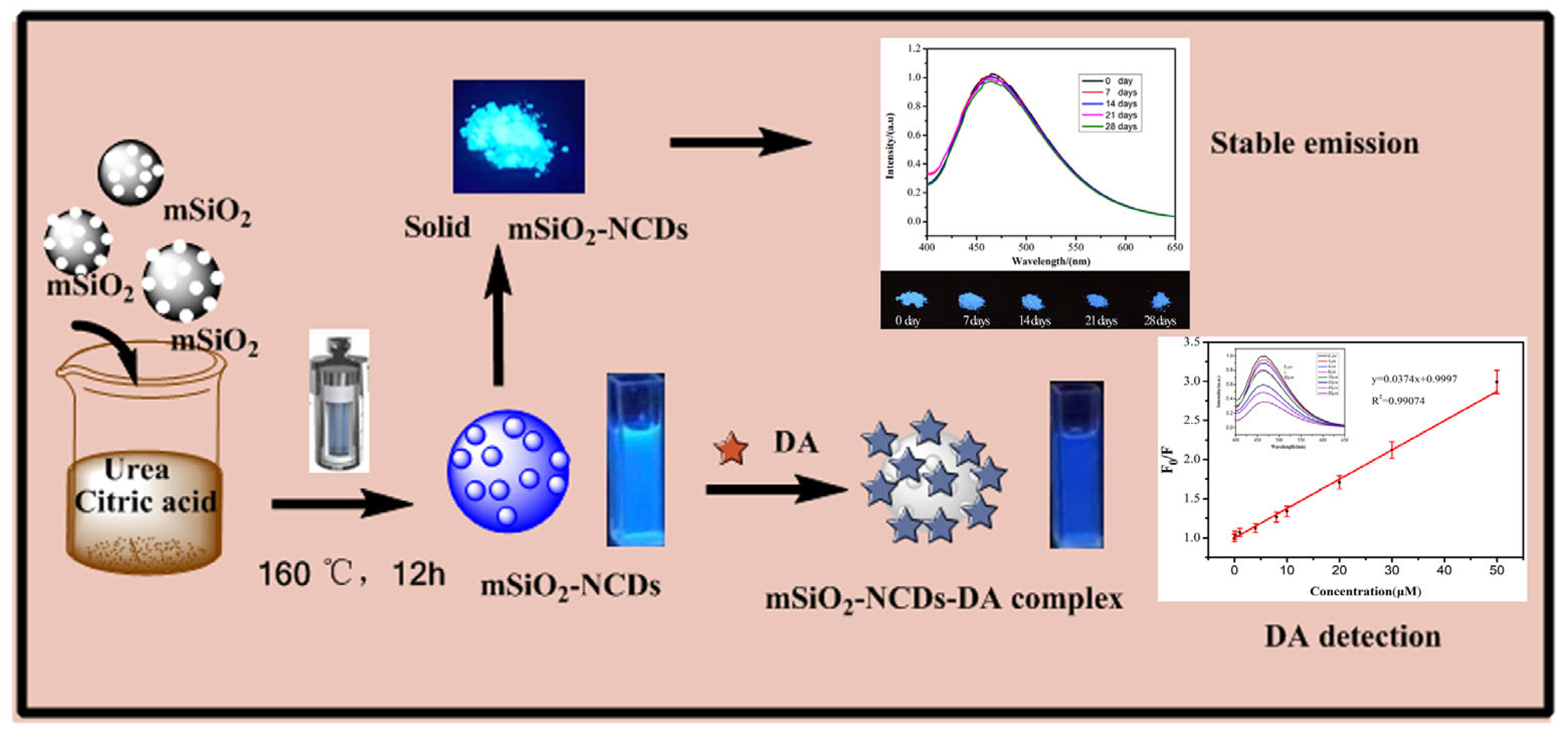

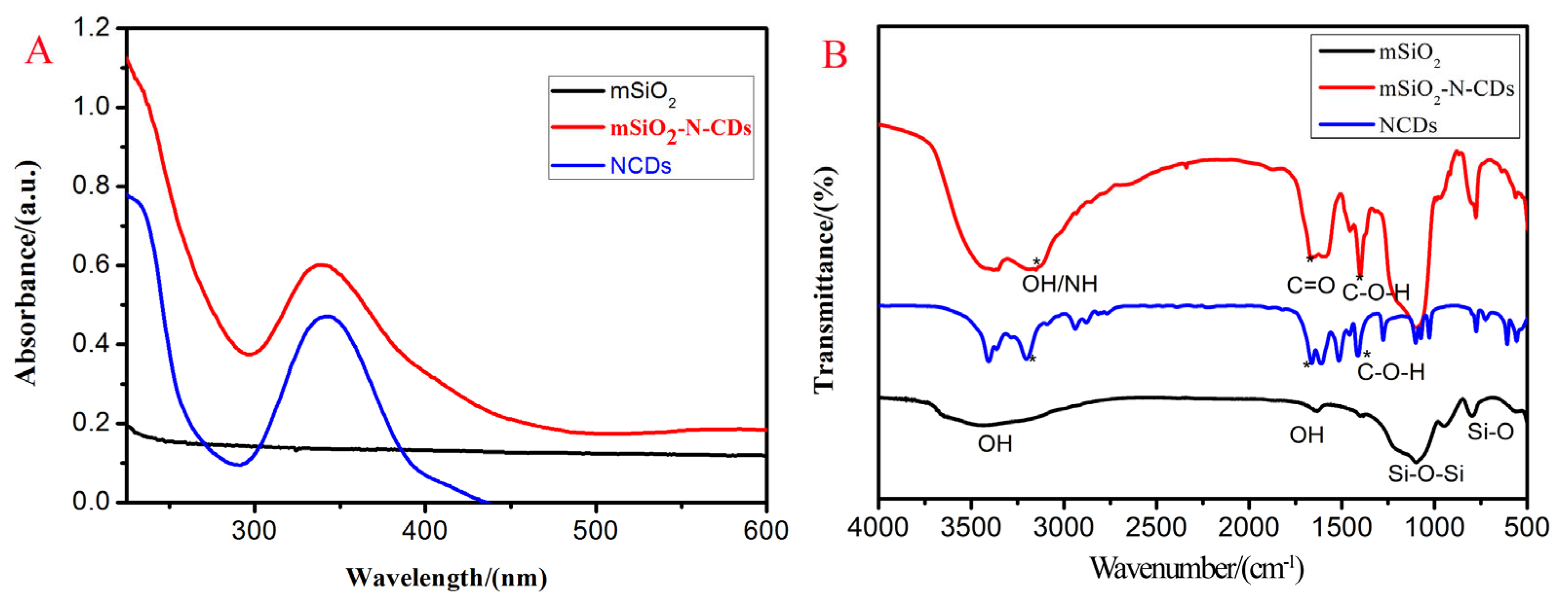
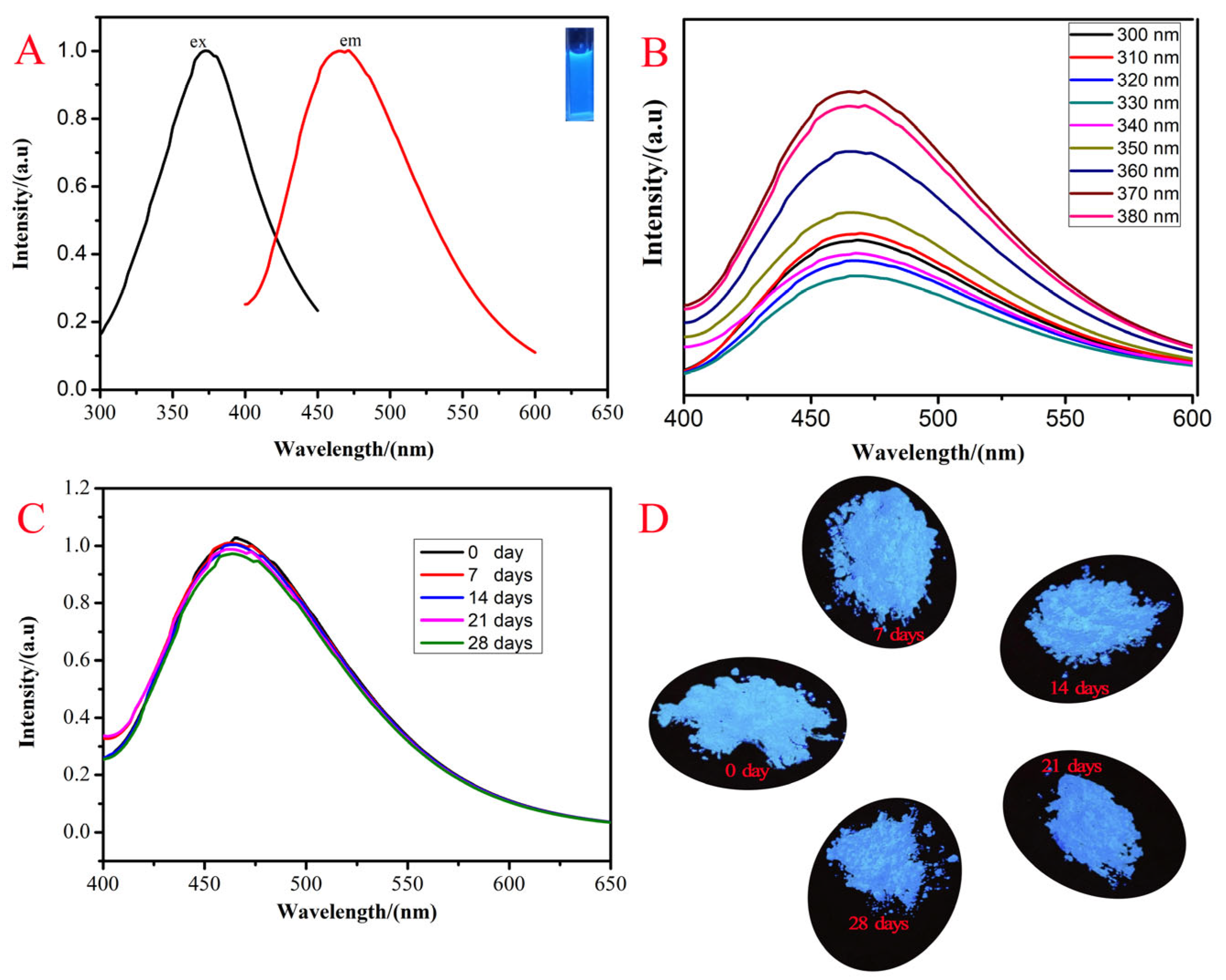

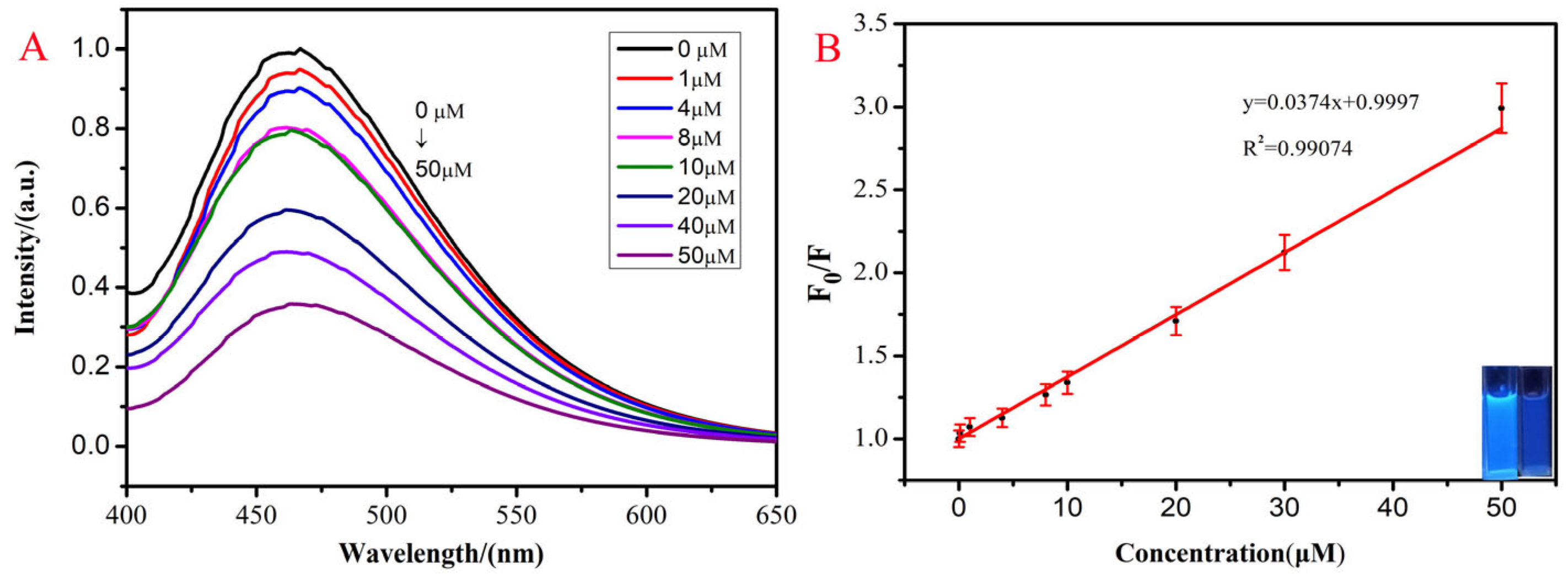
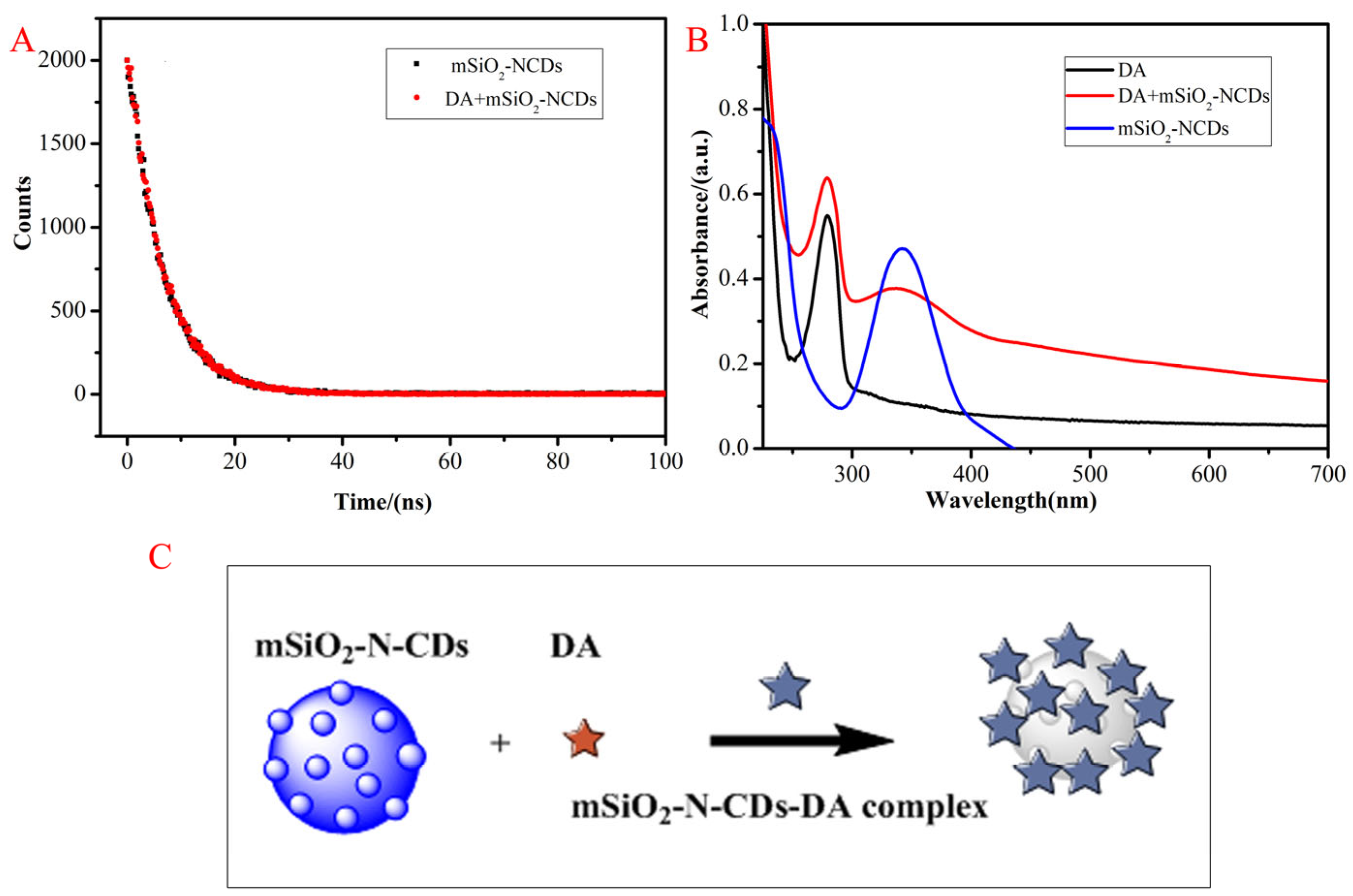
| Method | Probe | Liner Range (μM) | LOD (μM) | Reference |
|---|---|---|---|---|
| FL/quenching | Au@N-GQD | 0.0–80.0 | 0.52 | [25] |
| FL/quenching | F-CuInS2 | 0.5–40.0 | 0.2 | [26] |
| FL/quenching | S,N-CQD | 0–50 | 0.082 | [27] |
| FL/quenching | Fe-CQDs | 0.01–50 | 0.005 | [28] |
| FL/quenching | N-CQDs | 0.01–200 | 0.05 | [29] |
| FL/quenching | r-QDs@SiO2 | 10.0–80 | 0.12 | [51] |
| FL/quenching | GQDs | 0.25–50 | 0.09 | [52] |
| FL/quenching | mSiO2-N-CDs | 0–50 | 0.107 | This work |
| Sample | Added (µM) | Found (µM) | Recovery/% | RSD%, n = 3 |
|---|---|---|---|---|
| 1 | 0.5 | 0.49 | 98.0 | 0.71 |
| 2 | 1 | 0.99 | 99.0 | 1.80 |
| 3 | 5 | 5.04 | 100.8 | 2.0 |
| 4 | 40 | 40.30 | 100.8 | 2.0 |
Disclaimer/Publisher’s Note: The statements, opinions and data contained in all publications are solely those of the individual author(s) and contributor(s) and not of MDPI and/or the editor(s). MDPI and/or the editor(s) disclaim responsibility for any injury to people or property resulting from any ideas, methods, instructions or products referred to in the content. |
© 2023 by the authors. Licensee MDPI, Basel, Switzerland. This article is an open access article distributed under the terms and conditions of the Creative Commons Attribution (CC BY) license (https://creativecommons.org/licenses/by/4.0/).
Share and Cite
Guan, X.; Xu, X.; Wu, Y.; Yang, R.; Chen, X.; Kong, F.; Xiao, Q. One-Pot Hydrothermal Synthesis of mSiO2-N-CDs with High Solid-State Photoluminescence as a Fluorescent Probe for Detecting Dopamine. Nanomaterials 2023, 13, 2989. https://doi.org/10.3390/nano13232989
Guan X, Xu X, Wu Y, Yang R, Chen X, Kong F, Xiao Q. One-Pot Hydrothermal Synthesis of mSiO2-N-CDs with High Solid-State Photoluminescence as a Fluorescent Probe for Detecting Dopamine. Nanomaterials. 2023; 13(23):2989. https://doi.org/10.3390/nano13232989
Chicago/Turabian StyleGuan, Xiaogao, Xianzhu Xu, Yanli Wu, Ruchun Yang, Xi Chen, Fangfang Kong, and Qiang Xiao. 2023. "One-Pot Hydrothermal Synthesis of mSiO2-N-CDs with High Solid-State Photoluminescence as a Fluorescent Probe for Detecting Dopamine" Nanomaterials 13, no. 23: 2989. https://doi.org/10.3390/nano13232989
APA StyleGuan, X., Xu, X., Wu, Y., Yang, R., Chen, X., Kong, F., & Xiao, Q. (2023). One-Pot Hydrothermal Synthesis of mSiO2-N-CDs with High Solid-State Photoluminescence as a Fluorescent Probe for Detecting Dopamine. Nanomaterials, 13(23), 2989. https://doi.org/10.3390/nano13232989






